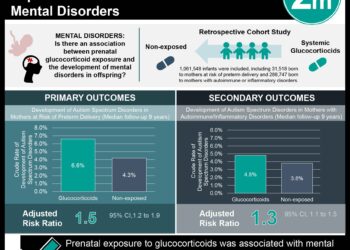Number of child psychiatrists is growing, but poor, rural areas remain underserved
1. A cross-sectional analysis of American Medical Association physician data between 2007 and 2016 indicated overall growth in the number of child psychiatrists per 100 000 children, but significantly lower numbers in counties with lower income and education levels.
2. Several states showed a decline in the number of child psychiatrists per 100 000 children during the study period, and the majority of counties in the United States did not have a child psychiatrist.
Evidence Rating Level: 3 (Average)
Study Rundown: Access to mental health care for children is limited by a shortage in child psychiatrists and growing demand for treatment. An earlier study of child psychiatrist levels in the United States was completed in 2006, and this study sought to extend the analysis by providing an assessment of national trends in the growth and distribution of child psychiatrists between 2007 and 2016. In this cross-sectional study, researchers linked physician data from the American Medical Association Area Health Resource Files to county-level sociodemographic data from the U.S. Census Bureau. Between 2007 and 2016, there was an approximately 20% growth in the number of practicing child psychiatrists per 100 000 children in the US. The ratio of child psychiatrists per 100 000 children declined in 6 states and rose by more than 50% in 6 other states. The majority of counties in the United States did not have a child psychiatrist. Child psychiatrists were significantly more likely to practice in counties with higher income, greater levels of education, larger African American populations, and in metropolitan areas.
These findings are limited by lack of data on physician practice setting or level of engagement in practice. Nonetheless, the study is strengthened by its large, nationally comprehensive data and examination of multiple covariates. For physicians, these findings highlight the continued geographic limitations to accessing child psychiatrists and suggest that alternative treatment frameworks may be necessary to address child mental health needs in underserved regions.
Click to read the study, published today in Pediatrics
Relevant reading: National Trends in the Mental Health Care of Children, Adolescents, and Adults by Office-Based Physicians
In-Depth [cross-sectional study]: Researchers used data from the American Medical Association Area Health Resource Files, U.S. Census Bureau, and U.S. Department of Commerce to compare the number of child psychiatrists per 100 000 children by area and county between 2007 and 2016. Multivariable negative binomial regression was used to examine sociodemographic characteristics associated with the density of child psychiatrists across the following covariates: year, child population at the county level, urbanicity, county-level sociodemographic variables, and county-level racial composition.
There was a 21.3% increase in the number of practicing child psychiatrists from 6590 in 2007 to 7991 in 2016. The number of child psychiatrists per 100 000 children grew from 8.01 to 9.75 between 2007 and 2016. This growth was not evenly distributed: 6 states had a declining ratio of child psychiatrists per 100 000 children while 6 states had a 50% or greater increase in the ratio. There were 0 child psychiatrists present in 70% of counties in both 2007 and 2016. Child psychiatrists were significantly more likely to practice in higher-income-quartile counties, and 74% of child psychiatrists resided in top-income-quartile counties. Counties with high levels of education, counties with larger African American populations, and metropolitan counties had significantly larger ratios of child psychiatrists per 100 000 children.
Image: PD
©2019 2 Minute Medicine, Inc. All rights reserved. No works may be reproduced without expressed written consent from 2 Minute Medicine, Inc. Inquire about licensing here. No article should be construed as medical advice and is not intended as such by the authors or by 2 Minute Medicine, Inc.







